Preparation and Structure–Property Relationship Study of Piezoelectric–Conductive Composite Polymer Nanofiber Materials for Bone Tissue Engineering
Abstract
1. Introduction
| Ref. | Key Findings | Materials | Advantages/Limitation | Materials Type | Advantages/Limitation | Materials | Key Findings | |
|---|---|---|---|---|---|---|---|---|
| [14] | Micro-bowl structures of PPY coating and ES have synergistic positive effects on osteoblast adhesion and differentiation. | PPY | Conducts electrical signals/inability to generate electrical signals autonomously | Conductive materials | Piezoelectric–conductive materials | Piezoelectricity and electrical conductivity, both self-generated and conductive electrical signals/Relatively complex preparation process | PVDF/RGO/PPY/PU | Janus structure of electrospun nanofibers has good electroactivity. Due to the structural features of Janus, the conductive phase of RGO/PPY enhances the piezoelectricity of the piezoelectric phase of PVDF with its piezoelectric constant d33 = 24.50 pC/N, which is higher than that of the pure PVDF fibers (d33 = 18.10 pC/N), and the conductivity of the composite fibers is unaffected with the electrical conductivity = 6.78 × 10−2 S/m, which is comparable to the pure conductive fiber (conductivity = 6.65 ± 0.13) × 10−2 S/m). |
| [5] | PCL/PPy exhibited enhanced MC3T3-E1 cell adhesion, proliferation, and differentiation in electrical stimulation conditions. | PLC/PPY | ||||||
| [15] | The RGO/PPY/PDA/Sr scaffold can enhance adhesion and proliferation of MC3T3-E1 cells. | RGO/PPY/PDA/Sr | ||||||
| [16] | Si-MNPs/PANI are biocompatible nanocomposites, and PANI and Si-MNPs provided electrical conductivity and magnetic susceptibility to the nanocomposite structures, respectively. | PANI/Si-MNPs | ||||||
| [17] | Nanocomposite AgNPs/PANI supported cell adhesion and proliferation. | AgNPs/PANI | ||||||
| [4] | The oxygen-containing functional group of GO forms a strong hydrogen bond with the fluorine group of PVDF, which induces the conversion of the α-phase to the β-phase. The PVDF/0.3GO scaffold had enhanced piezoelectricity compared to pure PVDF. | PVDF/GO | Autonomous generation of electrical signals/Cannot conduct electrical signals | Piezoelectric materials | ||||
| [18] | CPS self-hardened during hydration, and the microalkaline environment created during hydration facilitated the proliferation of osteoblasts and induced the formation of the β/γ phase in PVDF. | Ca-P-Si-doped PVDF | ||||||
| [19] | The surface charge upregulated the polarization behavior of the macrophages and guided the polarization phenotype. And the cell response of osseointegration in the proper direction can be coordinated by controlling the surface potential. | P(VDF-TrFE) | ||||||
2. Experimental Section
2.1. Materials
2.2. Fabrication of Nanofiber Membranes
2.2.1. Formulation of Spinning Solution for Piezoelectric Phase-PVDF
2.2.2. Optimization of Process Parameters for Conductive-Phase PU/RGO/PPY
2.2.3. Preparation of Piezoelectric–Conductive Composite Polymer Nanofiber Materials
2.3. Characterization
2.4. In Vitro Osteogenic Differentiation Assessment
2.5. Statistical Analysis
3. Results and Discussion
3.1. Optimization of Conductive-Phase Conductivity
3.2. Fabrication and Characterization of Piezoelectric–Conductive Polymer Nanofiber Materials
3.2.1. Preparation and Morphology of Piezoelectric–Conductive Polymer Fibers
3.2.2. Structural Features of Piezoelectric–Conductive Nanofibers in Relation to Their Piezoelectricity and Electrical Conductivity
- (1)
- Independent electroactive unit composite.
- (2)
- Single electroactivity of piezoelectric–conductive materials upon mutual doping.
- (3)
- Preferential polarization of piezoelectric materials.
3.2.3. FTIR of Piezoelectric–Conductive Nanofibers
3.2.4. Water Contact Angle Analysis of Piezoelectric–Conductive Nanofibers
3.2.5. Pore Structure Analysis of Piezoelectric–Conductive Nanofibers
3.2.6. Mechanical Properties of Piezoelectric–Conductive Nanofibers
3.3. In Vitro Cytocompatibility Assay
3.3.1. CCK-8 Assay to Detect Cell Proliferation
3.3.2. Alkaline Phosphatase Activity of Cells on Piezoelectric–Conductive Nanofibers
4. Conclusions
Author Contributions
Funding
Institutional Review Board Statement
Data Availability Statement
Conflicts of Interest
References
- Ohki, T.; Yamato, M.; Ota, M.; Takagi, R.; Kondo, M.; Kanai, N.; Okano, T.; Yamamoto, M. Application of regenerative medical technology using tissue-engineered cell sheets for endoscopic submucosal dissection of esophageal neoplasms. Dig. Endosc. 2015, 27, 182–188. [Google Scholar] [CrossRef]
- Ning, C.; Zhou, Z.; Tan, G.; Zhu, Y.; Mao, C. Electroactive polymers for tissue regeneration: Developments and perspectives. Prog. Polym. Sci. 2018, 81, 144–162. [Google Scholar] [CrossRef]
- Parssinen, J.; Hammaren, H.; Rahikainen, R.; Sencadas, V.; Ribeiro, C.; Vanhatupa, S.; Miettinen, S.; Lanceros-Mendez, S.; Hytonen, V.P. Enhancement of adhesion and promotion of osteogenic differentiation of human adipose stem cells by poled electroactive poly (vinylidene fluoride). J. Biomed. Mater. Res. A 2015, 103, 919–928. [Google Scholar] [CrossRef]
- Shuai, C.; Zeng, Z.; Yang, Y.; Qi, F.; Peng, S.; Yang, W.; He, C.; Wang, G.; Qian, G. Graphene oxide assists polyvinylidene fluoride scaffold to reconstruct electrical microenvironment of bone tissue. Mater. Des. 2020, 190, 108564. [Google Scholar] [CrossRef]
- Maharjan, B.; Kaliannagounder, V.K.; Jang, S.R.; Awasthi, G.P.; Bhattarai, D.P.; Choukrani, G.; Park, C.H.; Kim, C.S. In-situ polymerized polypyrrole nanoparticles immobilized poly(epsilon-caprolactone) electrospun conductive scaffolds for bone tissue engineering. Mater. Sci. Eng. C 2020, 114, 111056. [Google Scholar] [CrossRef]
- Wang, Z.L. Nanopiezotronics. Adv. Mater. 2007, 19, 889–892. [Google Scholar] [CrossRef]
- Saberi, A.; Jabbari, F.; Zarrintaj, P.; Saeb, M.R.; Mozafari, M. Electrically Conductive Materials: Opportunities and Challenges in Tissue Engineering. Biomolecules 2019, 9, 448. [Google Scholar] [CrossRef] [PubMed]
- Jin, Z.; Lu, B.; Xu, Y. Constructing an electrical microenvironment based on electroactive polymers in the field of bone tissue engineering. Int. J. Polym. Mater. 2023, 72, 937–967. [Google Scholar] [CrossRef]
- Cai, Z.; Xiong, P.; He, S.; Zhu, C. Improved piezoelectric performances of highly orientated poly(β-hydroxybutyrate) electrospun nanofiber membrane scaffold blended with multiwalled carbon nanotubes. Mater. Lett. 2019, 240, 213–216. [Google Scholar] [CrossRef]
- Zhou, Z. Construction of Electricity Microenvironment Based on Electroactive Polymer Membrane and Study of Its Interaction with Cells. Ph.D. Dissertation, South China University of Technology, Guangzhou, China, 2017. [Google Scholar]
- Du, L.; Li, T.; Jin, F.; Wang, Y.; Li, R.; Zheng, J.; Wang, T.; Feng, Z.Q. Design of high conductive and piezoelectric poly (3,4-ethylenedioxythiophene)/chitosan nanofibers for enhancing cellular electrical stimulation. J. Colloid Interface Sci. 2020, 559, 65–75. [Google Scholar] [CrossRef]
- Colapicchioni, V.; Millozzi, F.; Parolini, O.; Palacios, D. Nanomedicine, a valuable tool for skeletal muscle disorders: Challenges, promises, and limitations. Wires Nanomed. Nanobiotechnol. 2022, 14, e1777. [Google Scholar] [CrossRef] [PubMed]
- Zheng, X.; Kang, S.; Wang, K.; Yang, Y.; Yu, D.; Wan, F.; Williams, G.R.; Bligh, S.A. Combination of structure-performance and shape-performance relationships for better biphasic release in electrospun Janus fibers. Int. J. Pharm. 2021, 596, 120203. [Google Scholar] [CrossRef] [PubMed]
- Wu, M.; Zhang, F.; Zhangyang, Y.; Zhang, H.; Zhao, Y.; Xu, X.; Qin, M.; Ding, C.; Li, J. Electrically Facilitated Mineralization of Osteoblasts and Polypyrrole Micro-Bowl Coatings for Promotion of the Osteogenic Activity. Colloid Interface Sci. Commun. 2021, 43, 100450. [Google Scholar] [CrossRef]
- Wang, R.; Song, F.; Li, S.; Ding, L.; Xu, Z.; Zhang, B.; Wang, J.; Li, M.; Liu, B.; Qiu, Y. Polydopamine-Assisted Sr Immobilization to Improve the Osteogenesis of a Three Dimensional Reduced Graphene Oxide/Polypyrrole Composite Scaffold. Mater. Lett. 2019, 246, 182–185. [Google Scholar] [CrossRef]
- Lalegül-ülker, Ö.; Elçin, Y.M. Magnetic and electrically conductive silica-coated iron oxide/polyaniline nanocomposites for biomedical applications. Mater. Sci. Eng. C 2021, 119, 111600. [Google Scholar] [CrossRef]
- Perumal, A.; Kannan, S.; Nallaiyan, R. Silver nanoparticles incorporated polyaniline on TiO2 nanotube arrays: A nanocomposite platform to enhance the biocompatibility and antibiofilm. Surf. Interfaces 2021, 22, 100892. [Google Scholar] [CrossRef]
- Gong, T.; Li, T.; Meng, L.; Chen, Y.; Wu, T.; Zhou, J.; Lu, G.; Wang, Z. Fabrication of Piezoelectric Ca-P-Si-Doped PVDF Scaffold by Phase-Separation-Hydration: Material Characte rization, In Vitro Biocompatibility and Osteoblast Redifferentiation. Ceram. Int. 2022, 48, 6461–6469. [Google Scholar] [CrossRef]
- Wang, Z.; He, X.; Tang, B.; Chen, X.; Dong, L.; Cheng, K.; Weng, W. Polarization Behavior of Bone Marrow-Derived Macrophages on Charged P(VDF-TrFE) Coatings. Biomater. Sci. 2021, 9, 874–881. [Google Scholar] [CrossRef]
- Gong, X.; Xu, Y.; Zhou, J.; Wang, B.; Jin, Z. Preparation of β-phase PVDF Fiber Membrane and Optimization of Its Process Parameters. Eng. Plast. Appl. 2022, 50, 82–87. [Google Scholar] [CrossRef]
- Xiong, W.; Wang, X.; Guan, H.; Kong, F.; Xiao, Z.; Jing, Y.; Cai, L.; Hou, H.; Qiu, X.; Wang, L. A Vascularized Conductive Elastic Patch for the Repair of Infarcted Myocardium through Functional Vascular Anastomoses and Electrical Integration. Adv. Funct. Mater. 2022, 32, 2111273. [Google Scholar] [CrossRef]
- Sierpowska, J.; Toyras, J.; Hakulinen, M.A.; Saarakkala, S.; Jurvelin, J.S.; Lappalainen, R. Electrical and dielectric properties of bovine trabecular bone-relationships with mechanical properties and mineral density. Phys. Med. Biol. 2003, 48, 775–786. [Google Scholar] [CrossRef] [PubMed]
- Sierpowska, J.; Lammi, M.J.; Hakulinen, M.A.; Jurvelin, J.S.; Lappalainen, R.; Töyräs, J. Effect of human trabecular bone composition on its electrical properties. Med. Eng. Phys. 2007, 29, 845–852. [Google Scholar] [CrossRef] [PubMed]
- Xiao, T.; Li, P. Energy band theory and its applications in structural chemistry. J. Qinghai Norm. Univ. Nat. Sci. 1992, 3, 8. [Google Scholar] [CrossRef]
- Martins, P.; Lopes, A.C.; Lanceros-Mendez, S. Electroactive phases of poly (vinylidene fluoride): Determination, processing and applications. Prog. Polym. Sci. 2014, 39, 683–706. [Google Scholar] [CrossRef]
- Li, J.; Meng, Q.; Li, W.; Zhang, Z. Influence of crystalline properties on the dielectric and energy storage properties of poly (vinylidene fluoride). J. Appl. Polym. Sci. 2011, 122, 1659–1668. [Google Scholar] [CrossRef]
- Cai, X.; Lei, T.; Sun, D.; Lin, L. A critical analysis of the α, β and γ phases in poly (vinylidene fluoride) using FTIR. RSC Adv. 2017, 7, 15382–15389. [Google Scholar] [CrossRef]
- Salimi, A.; Yousefi, A.A. FTIR studies of b-phase crystal formation in stretched PVDF films. Polym. Test. 2003, 22, 699–704. [Google Scholar] [CrossRef]
- Murugesan, B.; Pandiyan, N.; Arumugam, M.; Sonamuthu, J.; Samayanan, S.; Yurong, C.; Juming, Y.; Mahalingam, S. Fabrication of palladium nanoparticles anchored polypyrrole functionalized reduced graphene oxide nanocomposite for antibiofilm associated orthopedic tissue engineering. Appl. Surf. Sci. 2020, 510, 145403. [Google Scholar] [CrossRef]
- Yang, R.; Li, X.; Wang, X.; Jia, L. Preparation of PVA/Ag antibacterial hydrophobic slow-release composite films with core–shell structure by one-step method. Mater. Lett. 2023, 352, 135086. [Google Scholar] [CrossRef]
- Jiang, Y.; Li, G.; Qiao, J.; Yan, P.; Tang, K. Hydrophobically modified hydrogel with enhanced tissue adhesion and antibacterial capacity for wound healing. Colloids Surf. B Biointerfaces 2023, 228, 113424. [Google Scholar] [CrossRef]
- Chen, X.; Zhou, J.; Qian, Y.; Zhao, L. Antibacterial coatings on orthopedic implants. Mater. Today Bio 2023, 19, 100586. [Google Scholar] [CrossRef]
- Zhang, J.; Sun, Y.; Guo, A.; Zhao, Y.; Lai, Y. Research progress of 3D printing magnesium-based biomaterials for bone defect repair. Chin. J. Bone Jt. Surg. 2021, 14, 826–831,836. [Google Scholar] [CrossRef]
- Masoumi Ravandi, M.R.; Dezianian, S.; Ahmad, M.T.; Ghoddosian, A.; Azadi, M. Compressive strength of metamaterial bones fabricated by 3D printing with different porosities in cubic cells. Mater. Chem. Phys. 2023, 299, 127515. [Google Scholar] [CrossRef]
- Raja, N.; Han, S.H.; Cho, M.; Choi, Y.; Jin, Y.; Park, H.; Lee, J.H.; Yun, H. Effect of porosity and phase composition in 3D printed calcium phosphate scaffolds on bone tissue regeneration in vivo. Mater. Des. 2022, 219, 110819. [Google Scholar] [CrossRef]
- Kanwar, S.; Al-Ketan, O.; Vijayavenkataraman, S. A novel method to design biomimetic, 3D printable stochastic scaffolds with controlled porosity for bone tissue engineering. Mater. Des. 2022, 220, 110857. [Google Scholar] [CrossRef]
- Gong, M.; Chi, C.; Ye, J.; Liao, M.; Xie, W.; Wu, C.; Shi, R.; Zhang, L. Icariin-loaded electrospun PCL/gelatin nanofiber membrane as potential artificial periosteum. Colloids Surf. B Biointerfaces 2018, 170, 201–209. [Google Scholar] [CrossRef] [PubMed]
- Zeng, Y.; Sun, X.; Yang, J.; Wu, W.; Xu, X.; Yan, Y. Mechanical properties of nasal fascia and periosteum. Clin. Biomech. 2003, 18, 760–764. [Google Scholar] [CrossRef]

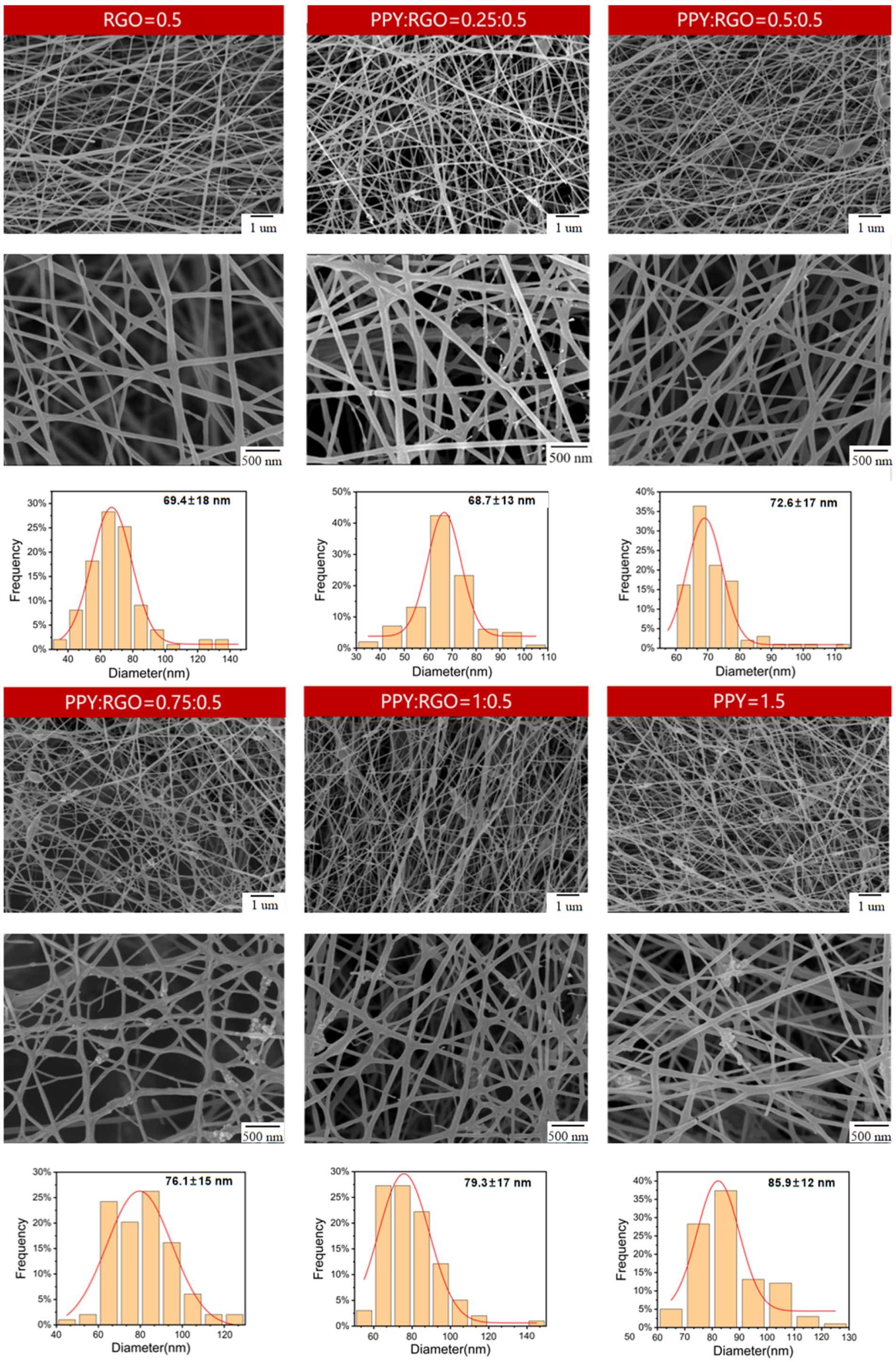
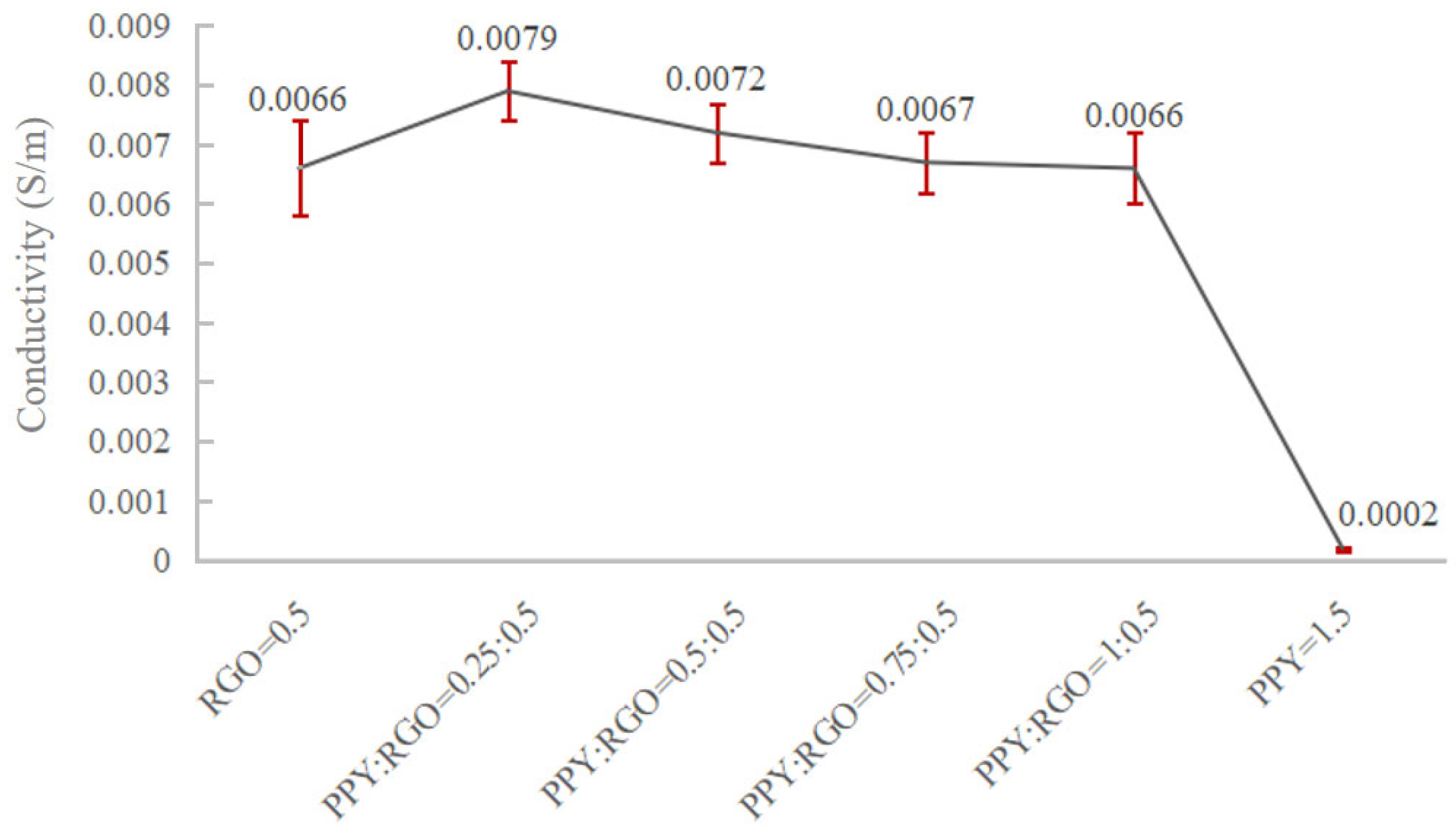
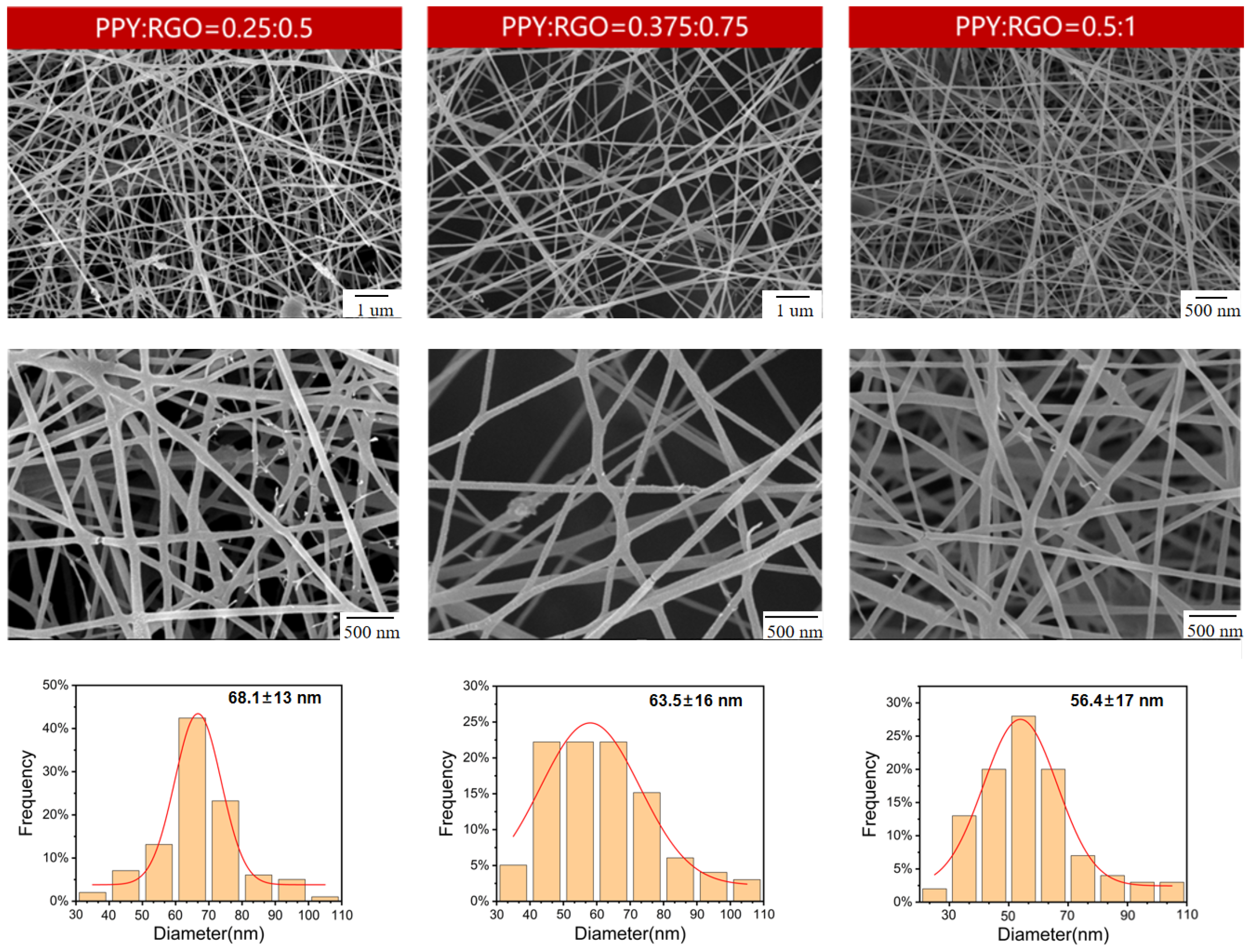
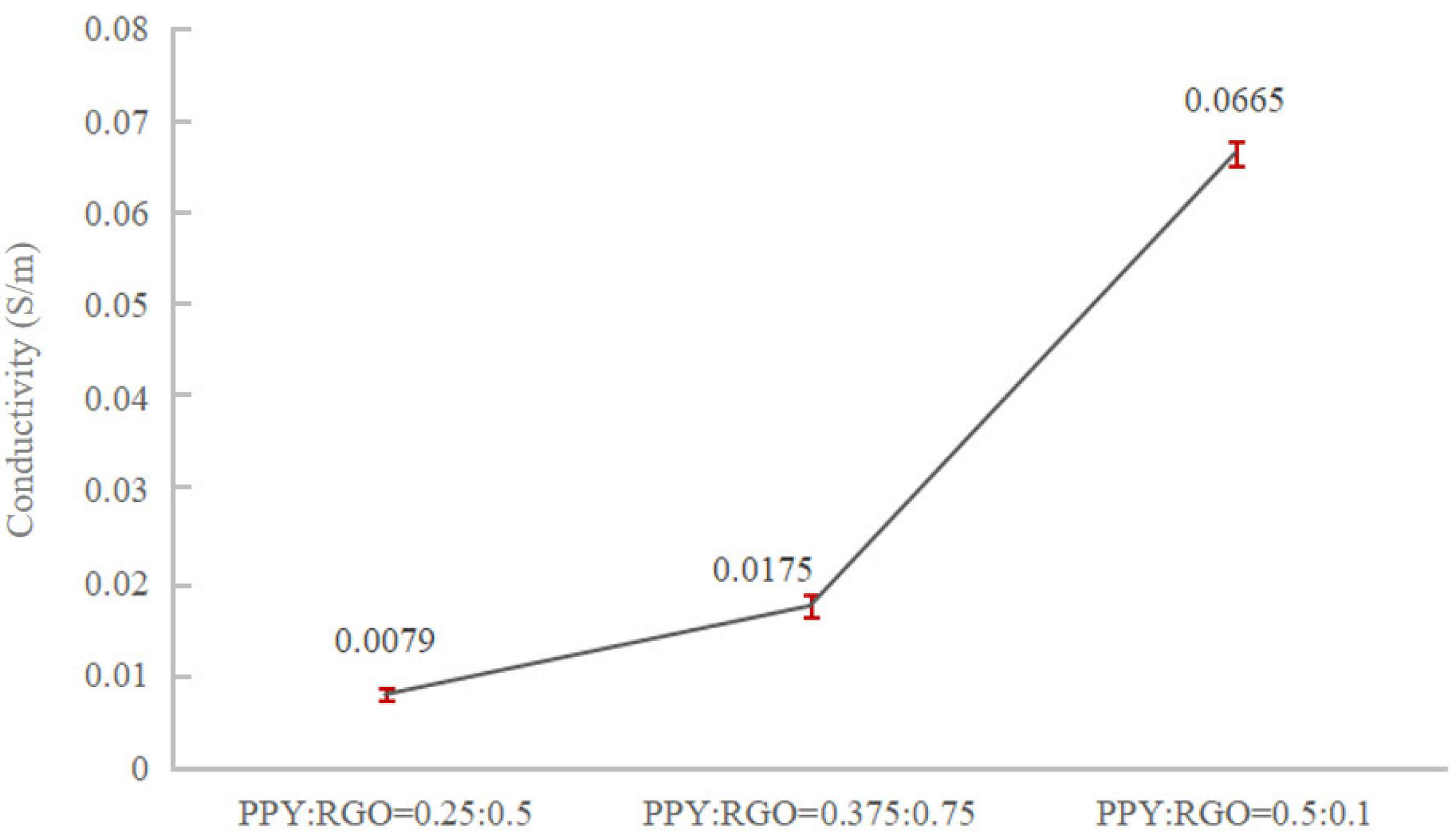

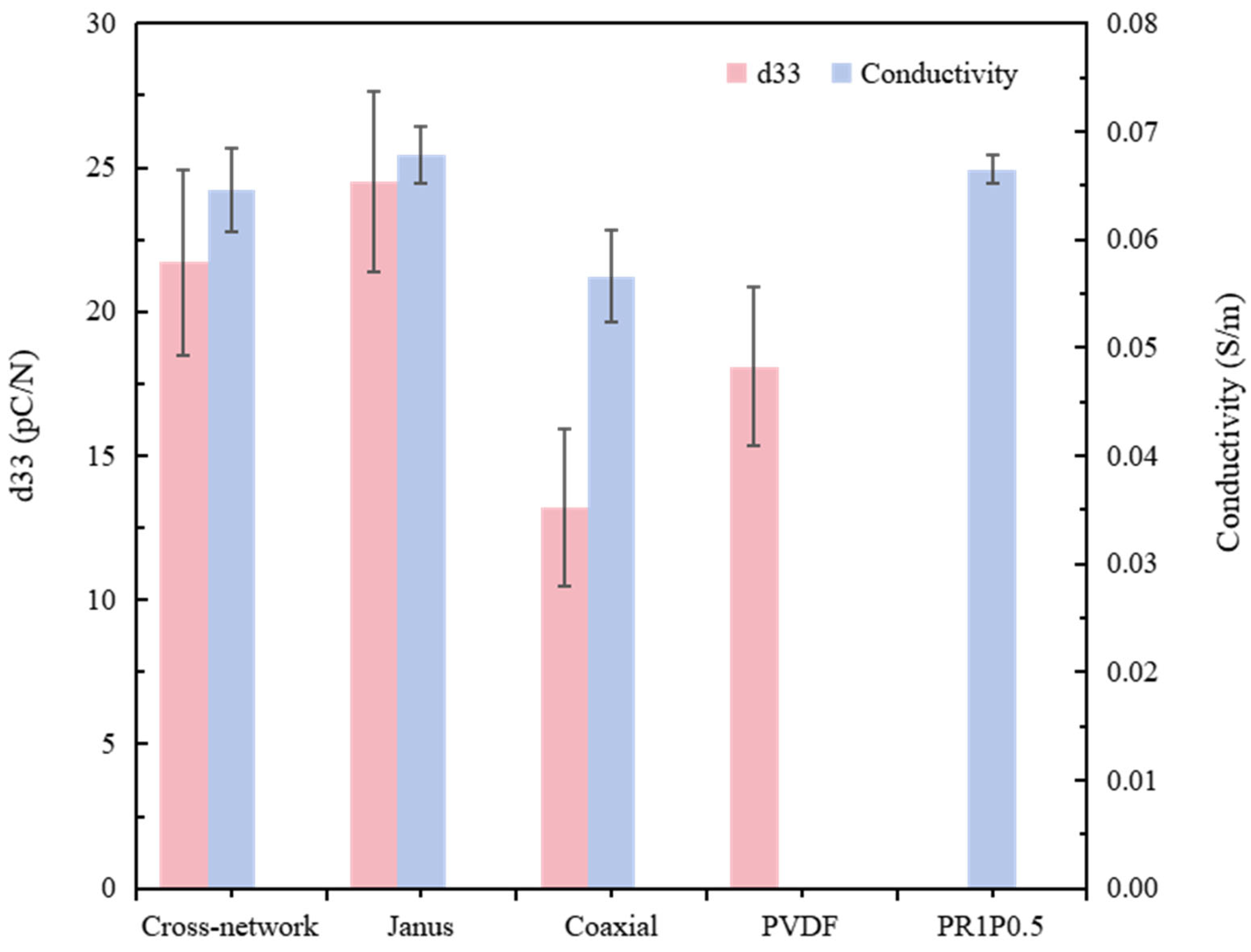


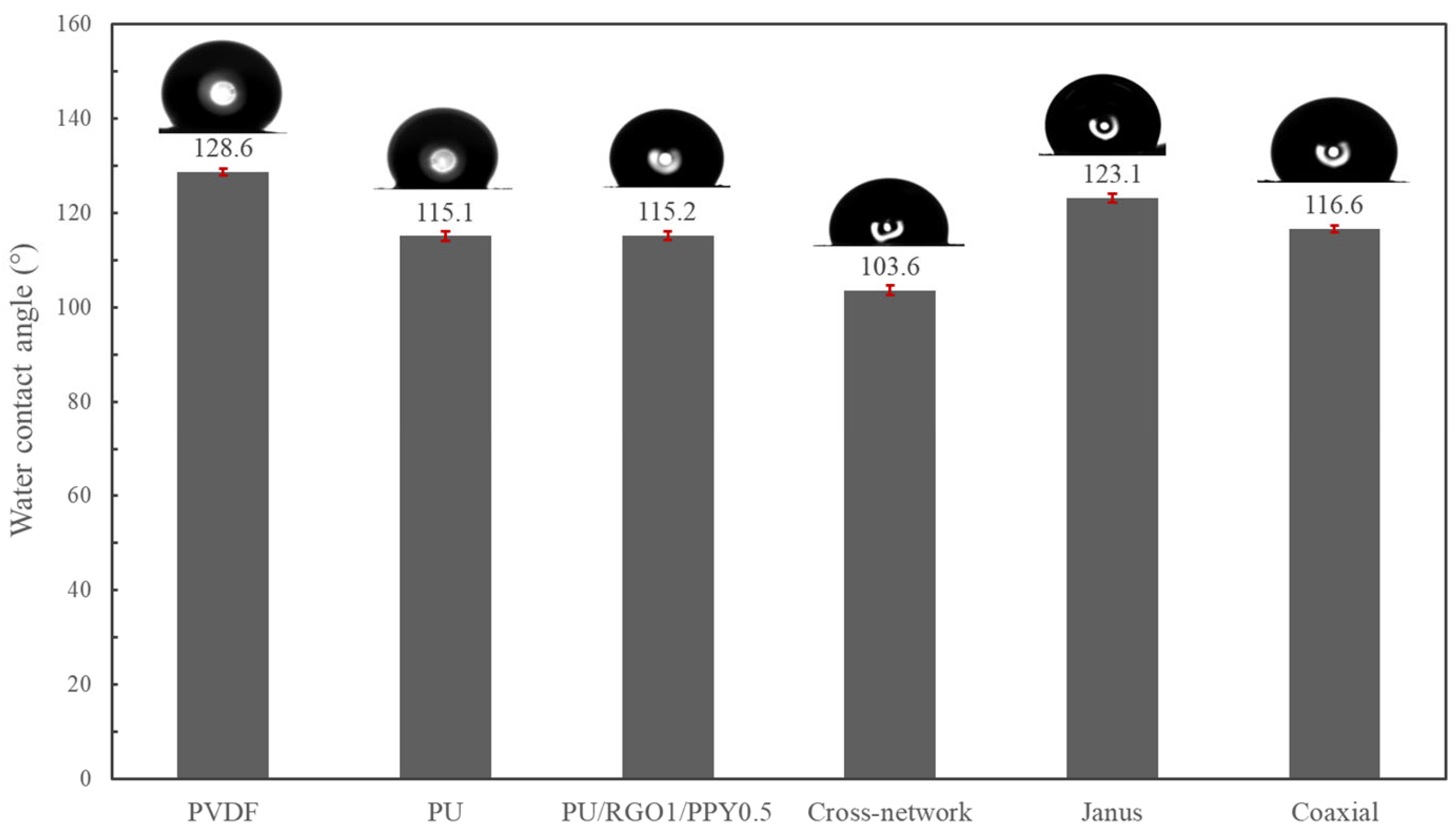
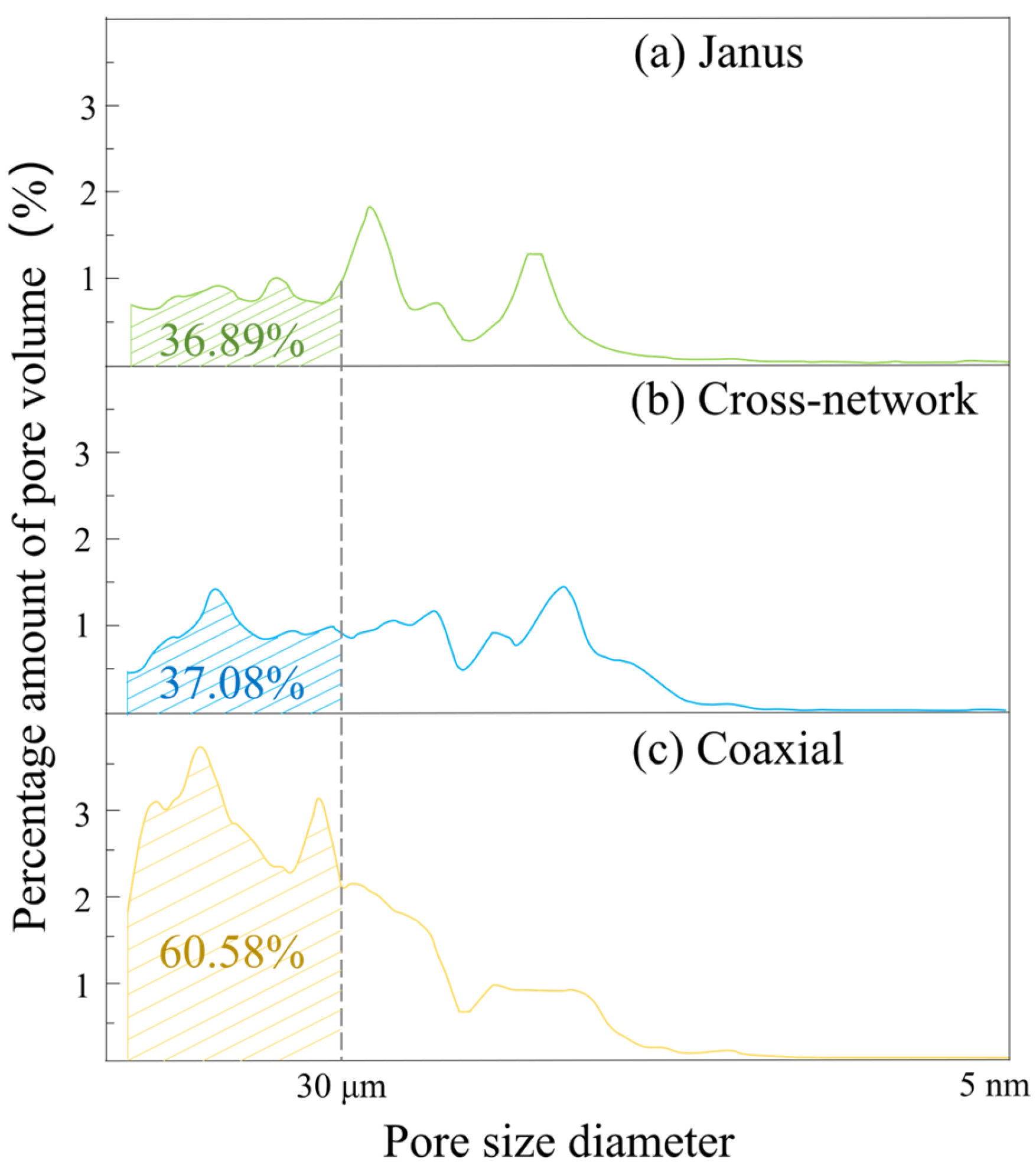

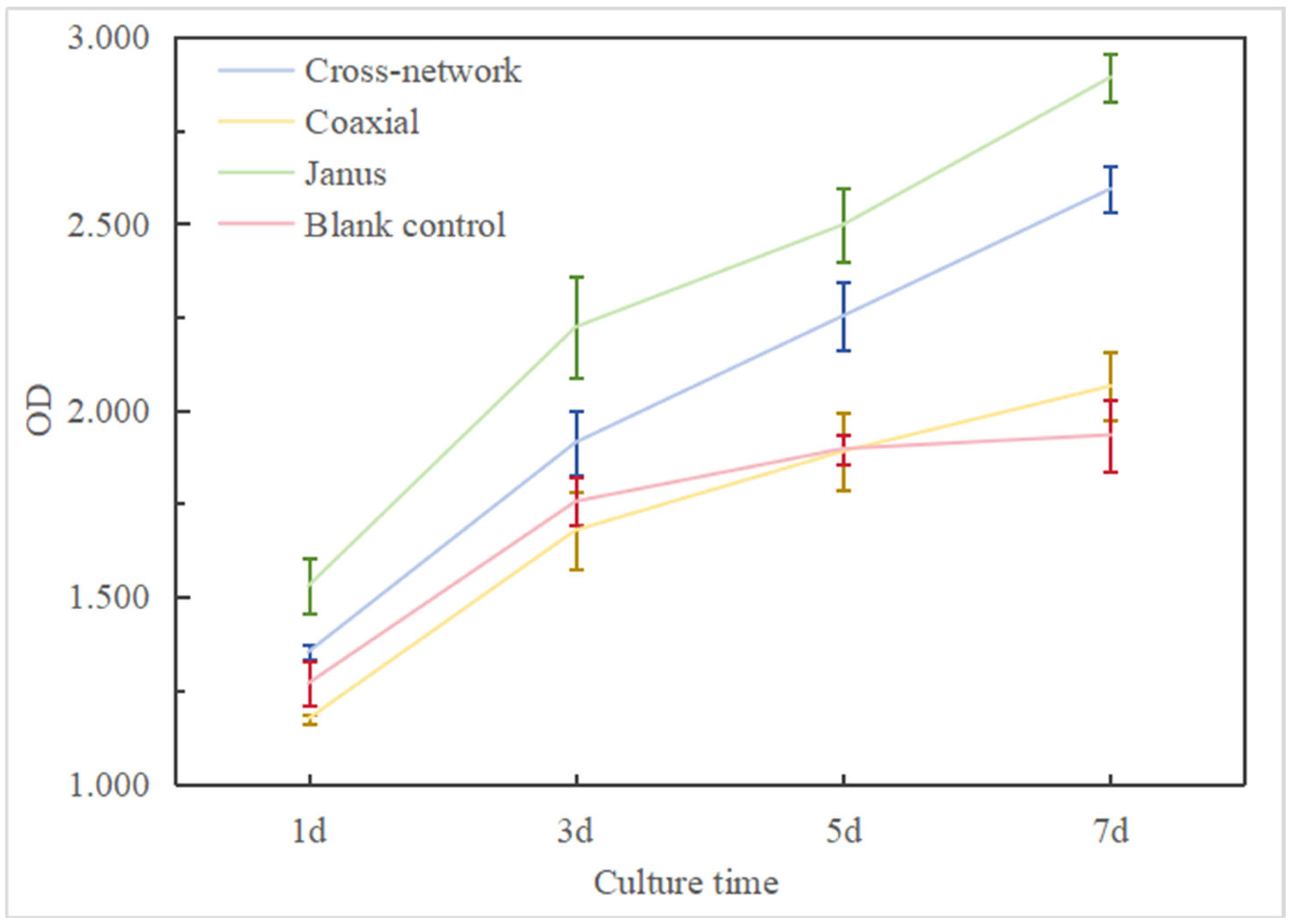
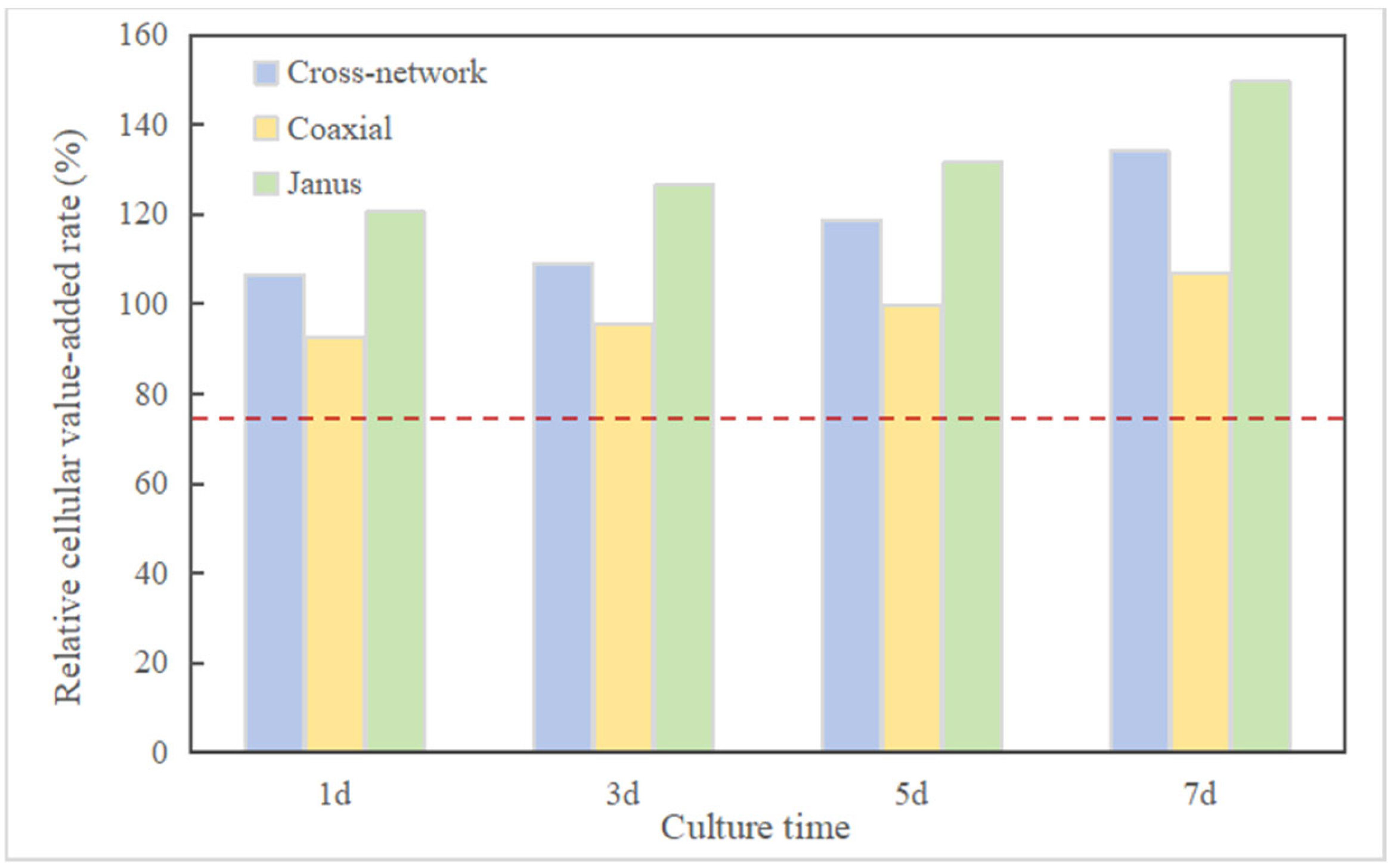
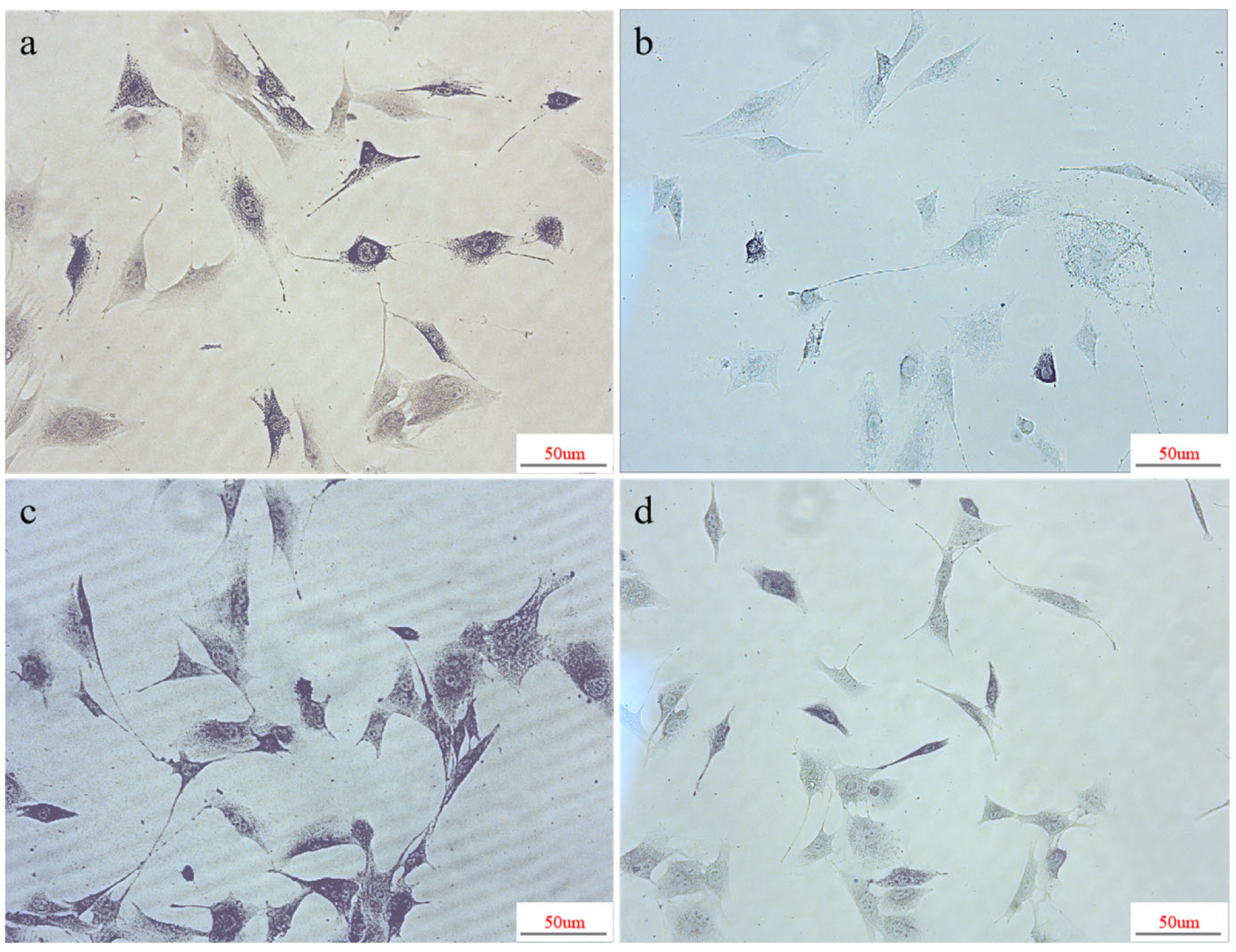
| PPY wt% | 0 | 0.25 | 0.5 | 0.75 | 1 | 1.5 |
| RGO wt% | 0.5 | 0.5 | 0.5 | 0.5 | 0.5 | 0 |
| PPY wt% | 0.25 | 0.375 | 0.5 | 0.75 |
| RGO wt% | 0.5 | 0.75 | 1.0 | 1.5 |
| Cross-Network | Janus | Coaxial | PVDF | PR1P0.5 | |
| d33 (pC/N) | 21.70 ± 3.20 | 24.50 ± 3.15 | 13.20 ± 2.71 | 18.10 ± 2.75 | 0 |
| Conductivity (S/m) | (6.46 ± 0.39) × 10−2 | (6.78 ± 0.26) × 10−2 | (5.66 ± 0.43) × 10−2 | 0 | (6.65 ± 0.13) × 10−2 |
| Janus | Cross-Network | Coaxial | |
| Pore diameter (nm) | 1194.36 | 2264.46 | 6947.28 |
| Porosity | 70.09% | 71.10% | 78.96% |
| Total percentage of pore volume with pore diameter ≥30 μm | 36.89% | 37.08% | 60.58% |
| Group | Time (day) | F | p | |||
|---|---|---|---|---|---|---|
| 1d | 3d | 5d | 7d | |||
| Cross-network | 1.353 ± 0.020 | 1.914 ± 0.087 | 2.253 ± 0.090 | 2.593 ± 0.063 | 166.385 | <0.001 |
| Coaxial | 1.173 ± 0.012 | 1.679 ± 0.105 | 1.890 ± 0.105 | 2.065 ± 0.090 | 58.004 | <0.001 |
| Janus | 1.530 ± 0.075 | 2.223 ± 0.137 | 2.497 ± 0.097 | 2.892 ± 0.064 | 103.718 | <0.001 |
| Blank control | 1.269 ± 0.059 | 1.756 ± 0.064 | 1.897 ± 0.040 | 1.934 ± 0.096 | 61.025 | <0.001 |
| F | 28.187 | 16.595 | 34.626 | 95.178 | ||
| p | <0.001 | <0.001 | <0.001 | <0.001 | ||
| Time main effect | 344.111 | <0.001 | ||||
| Group main effect | 154.163 | <0.001 | ||||
| Time × Group | 8.226 | <0.001 | ||||
| Toxicity Degrees | Relative Proliferation Rate (%) | Cytotoxicity Evaluation |
|---|---|---|
| 0 | ≥100 | Non-cytotoxic |
| 1 | 75–99 | Non-cytotoxic |
| 2 | 50–74 | Mild cytotoxicity |
| 3 | 25–49 | Moderate cytotoxicity |
| 4 | 1–24 | Moderate cytotoxicity |
| 5 | 0 | Severe cytotoxicity |
| Group | Time (day) | |||||||
|---|---|---|---|---|---|---|---|---|
| 1d | 3d | 5d | 7d | |||||
| Relative Proliferation Rate (%) | Toxicity Degrees | Relative Proliferation Rate | Toxicity Degrees | Relative Proliferation Rate | Toxicity Degrees | Relative Proliferation Rate | Toxicity Degrees | |
| Cross-network | 106.09 | 0 | 109.02 | 0 | 118.77 | 0 | 134.07 | 0 |
| Coaxial | 92.46 | 1 | 95.63 | 1 | 99.61 | 1 | 106.77 | 0 |
| Janus | 120.54 | 0 | 126.61 | 0 | 131.65 | 0 | 149.52 | 0 |
Disclaimer/Publisher’s Note: The statements, opinions and data contained in all publications are solely those of the individual author(s) and contributor(s) and not of MDPI and/or the editor(s). MDPI and/or the editor(s) disclaim responsibility for any injury to people or property resulting from any ideas, methods, instructions or products referred to in the content. |
© 2024 by the authors. Licensee MDPI, Basel, Switzerland. This article is an open access article distributed under the terms and conditions of the Creative Commons Attribution (CC BY) license (https://creativecommons.org/licenses/by/4.0/).
Share and Cite
Jin, Z.; Wei, S.; Jin, W.; Lu, B.; Xu, Y. Preparation and Structure–Property Relationship Study of Piezoelectric–Conductive Composite Polymer Nanofiber Materials for Bone Tissue Engineering. Polymers 2024, 16, 1952. https://doi.org/10.3390/polym16131952
Jin Z, Wei S, Jin W, Lu B, Xu Y. Preparation and Structure–Property Relationship Study of Piezoelectric–Conductive Composite Polymer Nanofiber Materials for Bone Tissue Engineering. Polymers. 2024; 16(13):1952. https://doi.org/10.3390/polym16131952
Chicago/Turabian StyleJin, Zhengyang, Suiyan Wei, Wenyang Jin, Bingheng Lu, and Yan Xu. 2024. "Preparation and Structure–Property Relationship Study of Piezoelectric–Conductive Composite Polymer Nanofiber Materials for Bone Tissue Engineering" Polymers 16, no. 13: 1952. https://doi.org/10.3390/polym16131952
APA StyleJin, Z., Wei, S., Jin, W., Lu, B., & Xu, Y. (2024). Preparation and Structure–Property Relationship Study of Piezoelectric–Conductive Composite Polymer Nanofiber Materials for Bone Tissue Engineering. Polymers, 16(13), 1952. https://doi.org/10.3390/polym16131952







